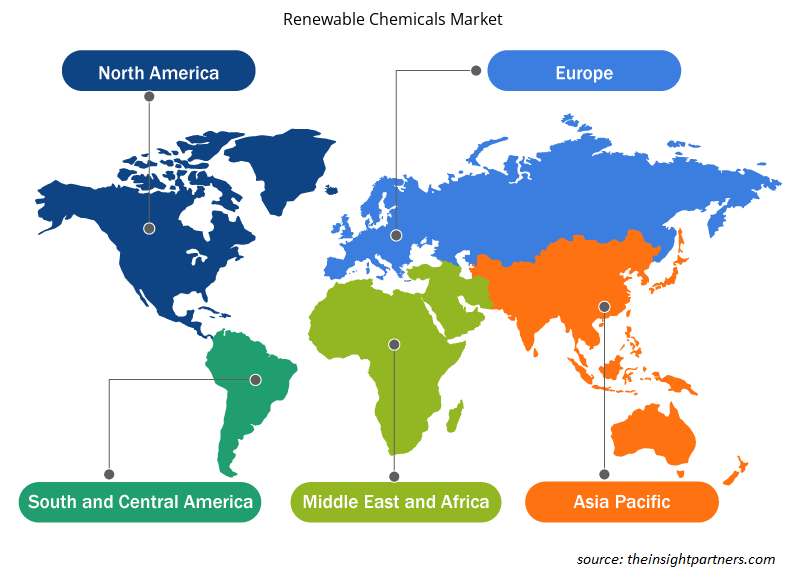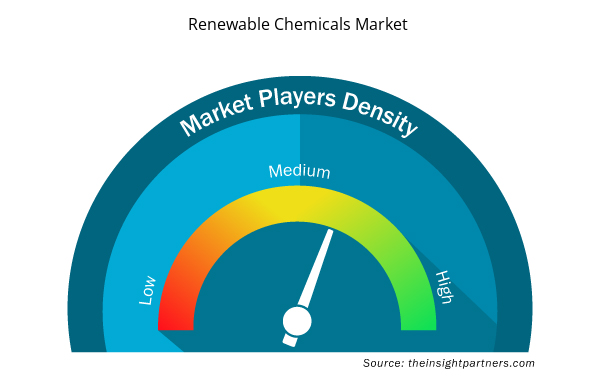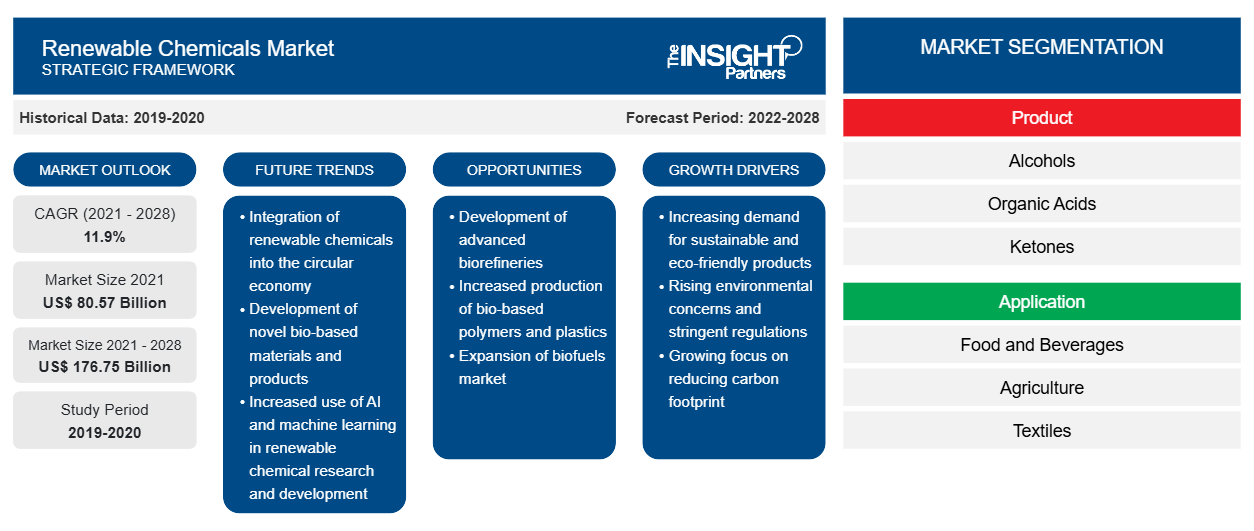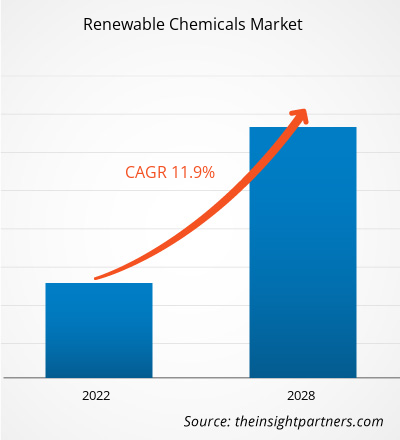بلغت قيمة سوق المواد الكيميائية المتجددة 80,566.30 مليون دولار أمريكي في عام 2021، ومن المتوقع أن تنمو بمعدل نمو سنوي مركب نسبته 11.9٪ من عام 2021 إلى عام 2028.
تُعرَّف المواد الكيميائية المتجددة أو المواد الكيميائية القائمة على المواد الحيوية بأنها تلك الفئات من المواد الكيميائية التي يتم تصنيعها من مصادر متجددة مثل المواد الخام الزراعية والنفايات الزراعية ومنتجات النفايات العضوية والكتلة الحيوية والكائنات الحية الدقيقة. تُصنَّف المواد الكيميائية المتجددة على أنها مواد كيميائية مستدامة وصديقة للبيئة تنبعث منها بصمات كربونية أقل مقارنة بالمواد الكيميائية التقليدية القائمة على البترول. بعض المواد الكيميائية المتجددة الأكثر توفرًا هي اللجنين والكربوهيدرات والزيوت ومستخلصات النباتات والهيميسليلوز والسليلوز والنشا والبروتين وغيرها. تجد هذه المواد الكيميائية تطبيقًا في قواعد تطبيق متنوعة مثل الأغذية والمشروبات والزراعة والمنسوجات والسيارات والتعبئة والتغليف وغيرها.
في عام 2021، ساهمت أمريكا الشمالية بأكبر حصة في سوق المواد الكيميائية المتجددة العالمية. ترجع هيمنة سوق المواد الكيميائية المتجددة في هذه المنطقة في المقام الأول إلى وجود قاعدة صناعية قوية مع مساهمة الشركات المصنعة البارزة بشكل كبير في نمو السوق. الطلب المرتفع على المواد الكيميائية المتجددة من تطبيقات مثل الأغذية والمشروبات والزراعة والمنسوجات والنقل والتعبئة والتغليف وغيرها من الصناعات المدعومة بنمو كبير في القواعد الصناعية للاستخدام النهائي يحفز الطلب على المواد الكيميائية المتجددة في السوق الإقليمية. يوفر ارتفاع الاستثمار في قطاع التصنيع جنبًا إلى جنب مع التركيز المتزايد على الحلول الصديقة للبيئة والمستدامة فرصًا مربحة لنمو سوق المواد الكيميائية المتجددة في أمريكا الشمالية. علاوة على ذلك، من المتوقع أن تخلق السياسات المواتية لتعزيز استخدام المواد الكيميائية الحيوية والمتجددة على المواد الكيميائية التقليدية القائمة على البترول فرص نمو مربحة في المنطقة.
قم بتخصيص هذا التقرير ليناسب متطلباتك
ستحصل على تخصيص لأي تقرير - مجانًا - بما في ذلك أجزاء من هذا التقرير، أو تحليل على مستوى الدولة، وحزمة بيانات Excel، بالإضافة إلى الاستفادة من العروض والخصومات الرائعة للشركات الناشئة والجامعات
- احصل على أهم اتجاهات السوق الرئيسية لهذا التقرير.ستتضمن هذه العينة المجانية تحليلاً للبيانات، بدءًا من اتجاهات السوق وحتى التقديرات والتوقعات.
تأثير جائحة كوفيد-19 على سوق المواد الكيميائية المتجددة
لقد غير الوباء المستمر بشكل كبير وضع القطاع الصناعي وأثر سلبًا على نمو سوق المواد الكيميائية المتجددة. أدى تنفيذ التدابير لمكافحة انتشار الفيروس إلى تفاقم الوضع وأثر على نمو العديد من القطاعات الصناعية. تأثرت الصناعات مثل الأغذية والمشروبات والزراعة والمنسوجات والنقل والتعبئة والتغليف والمستحضرات الصيدلانية بالتشوهات المفاجئة في الكفاءة التشغيلية والاضطرابات في سلاسل القيمة المنسوبة إلى الإغلاق المفاجئ للحدود الوطنية والدولية. أثر الانخفاض الكبير في نمو العديد من القطاعات الصناعية سلبًا على الطلب على المواد الكيميائية المتجددة في السوق العالمية. أثرت الاضطرابات من حيث مصادر المواد الخام من الموردين وكذلك الإغلاق المؤقت لقاعدة التصنيع بسبب عمليات الإغلاق غير المحددة والحجر الصحي المؤقت على نمو السوق خلال فترة الوباء. ومع ذلك، مع تخطيط الاقتصادات لإحياء عملياتها، من المتوقع أن يرتفع الطلب على المواد الكيميائية المتجددة عالميًا. على الرغم من أن التركيز على الإنتاج في الوقت المناسب هو عامل آخر مثير للقلق يعيق نمو السوق. ومن المتوقع أن يؤدي الطلب المتزايد على المواد الكيميائية المتجددة في قطاعات الأغذية والمشروبات والزراعة والمنسوجات والنقل والتعبئة والتغليف والأدوية وغيرها من الصناعات إلى جانب الاستثمارات الكبيرة من قبل الشركات المصنعة البارزة إلى دفع نمو المواد الكيميائية المتجددة.
رؤى السوق
الوعي المتزايد بشأن المواد الكيميائية المتجددة مدعوم بمخاوف بيئية متزايدة
لقد تم اعتبار العلوم المتجددة واحدة من الطرق الفعالة لتعزيز جودة الهواء والماء والتربة والمساهمة في الاستدامة من خلال تسويق استخدام المواد الكيميائية الحيوية الصديقة للبيئة في تطبيقات متنوعة. يمكن الحصول على المواد الكيميائية المتجددة المستدامة الصديقة للبيئة من المواد الخام المتجددة مثل الكتلة الحيوية أو المخلفات الزراعية أو المواد الخام والكائنات الحية الدقيقة بمساعدة تخليق الكيمياء الخضراء أو المصافي الحيوية. لقد نفذت حكومات العديد من الاقتصادات لوائح صارمة تتعلق بانبعاثات الكربون والغازات المسببة للانحباس الحراري العالمي لتعزيز جودة البيئة. على سبيل المثال، تهدف المفوضية الأوروبية إلى تحقيق انخفاض بنسبة 80٪ في انبعاثات الكربون بحلول عام 2050 من خلال التخلص التدريجي من حوالي 81 مليون طن من ثاني أكسيد الكربون لاستخدامه في إنتاج الكلنكر. تفرض الهيئات التنظيمية، مثل REACH (التسجيل والتقييم والترخيص وتقييد المواد الكيميائية)، ووكالة حماية البيئة (EPA)، والمفوضية الأوروبية، لوائح بيئية صارمة على إنتاج والتخلص من البتروكيماويات. كما أن التركيز المتزايد للاتحاد الأوروبي على إنشاء "الاقتصاد الأخضر" إلى جانب مبادرته "20-20-20" يعمل على التخلص التدريجي من الطلب على البتروكيماويات. إن انخفاض موارد البترول إلى جانب عدم الاستقرار السياسي في الدول المنتجة للنفط الرائدة وتقلب أسعار المنتجات البترولية يزيد من تفضيل المواد الكيميائية المتجددة. إن الانحباس الحراري العالمي وتغير المناخ يخلقان الطلب على المنتجات الصحية والخضراء والنظيفة. بالإضافة إلى ذلك، يخلق الاقتصاد الدائري أكثر من 5.6 تريليون دولار أمريكي من الفرص الجديدة لتطوير التقنيات الصديقة للبيئة بما في ذلك التكنولوجيا المرتبطة بالمواد الكيميائية المتجددة. مثل هذه الجهود التعاونية واللوائح والمبادرات تدفع نمو سوق المواد الكيميائية المتجددة.
رؤى المنتج
بناءً على المنتج، يتم تصنيف سوق المواد الكيميائية المتجددة إلى الكحولات والأحماض العضوية والكيتونات والمواد الكيميائية الأساسية والبوليمرات الحيوية وغيرها. من المتوقع أن يكون قطاع البوليمرات الحيوية هو القطاع الأسرع نموًا في سوق المواد الكيميائية المتجددة العالمية خلال فترة التنبؤ. من المتوقع أن يؤدي الطلب المتزايد على مواد التغليف الخضراء إلى جانب الاستخدام المتزايد للبوليمرات الحيوية في صناعة السيارات إلى دفع نمو البوليمرات الحيوية في سوق المواد الكيميائية المتجددة. تشمل البوليمرات الحيوية البولينيوكليوتيدات (DNA، RNA)، والسليلوز، والكيتوزان، والكيتين، والنشا، والبروتينات، والبوليستر، والبكتين، والكولاجين، والجيلاتين، والغلوتين، وغيرها. إنها بديل مبتكر وواعد للحد من انبعاثات الغازات المسببة للانحباس الحراري العالمي والسامة، واستخدام الموارد غير المتجددة. من المتوقع أن يعزز التركيز المتزايد على المواد الصديقة للبيئة والمستدامة الطلب على البوليمرات الحيوية.
رؤى التطبيق
بناءً على التطبيق، يتم تصنيف سوق المواد الكيميائية المتجددة إلى الأغذية والمشروبات والزراعة والمنسوجات والنقل والوسطاء الكيميائيين والتعبئة والتغليف والأدوية الحيوية والمستحضرات الصيدلانية وغيرها. في عام 2021، يهيمن قطاع النقل على سوق المواد الكيميائية المتجددة. يتم تحويل الكتلة الحيوية ورقائق الخشب وبقايا المحاصيل وما إلى ذلك إلى وقود نقل متجدد. تُستخدم الأنواع المختلفة من الكحوليات الحيوية مثل البيوتانول الحيوي والإيثانول الحيوي والميثانول الحيوي كوقود للطائرات النفاثة. الإيثانول الحيوي هو المصدر الأكثر استخدامًا للطاقة في النقل. من المتوقع أن يزداد استخدام الإيثانول الحيوي بشكل كبير في السنوات القادمة ويظل مرتفعًا. سيوفر هذا التحول نحو المزيد من استخدام الإيثانول الحيوي المزيد من الفرص في المستقبل. الميثان هو مادة كيميائية متجددة أخرى تستخدم كوقود للنقل وهو المكون الرئيسي للغاز الطبيعي المضغوط. يتم إنتاجه من الكتلة الحيوية من خلال عملية كيميائية حيوية تسمى الهضم اللاهوائي. الديزل الحيوي هو بديل وقود ديزل متجدد يتم إنتاجه عن طريق خلط أي زيت طبيعي أو دهون مع الكحول (عادةً الميثانول). يمكن أيضًا تحويل الزيوت النباتية المختلفة والدهون الحيوانية وشحوم الطهي المعاد تدويرها إلى وقود الديزل الحيوي.
من بين اللاعبين الرئيسيين الرئيسيين العاملين في سوق المواد الكيميائية المتجددة شركة BASF SE؛ وشركة Amyris Inc؛ وشركة DSM؛ وشركة Archer-Daniels-Midland Company (ADM)؛ وشركة Dow Chemical Company. وتركز هذه الشركات العاملة في السوق بشكل كبير على تطوير عروض المنتجات عالية الجودة والمبتكرة.
رؤى إقليمية حول سوق المواد الكيميائية المتجددة
لقد قام المحللون في Insight Partners بشرح الاتجاهات والعوامل الإقليمية المؤثرة على سوق المواد الكيميائية المتجددة طوال فترة التوقعات بشكل شامل. يناقش هذا القسم أيضًا قطاعات سوق المواد الكيميائية المتجددة والجغرافيا في جميع أنحاء أمريكا الشمالية وأوروبا ومنطقة آسيا والمحيط الهادئ والشرق الأوسط وأفريقيا وأمريكا الجنوبية والوسطى.

- احصل على البيانات الإقليمية المحددة لسوق المواد الكيميائية المتجددة
نطاق تقرير سوق المواد الكيميائية المتجددة
| سمة التقرير | تفاصيل |
|---|---|
| حجم السوق في عام 2021 | 80.57 مليار دولار أمريكي |
| حجم السوق بحلول عام 2028 | 176.75 مليار دولار أمريكي |
| معدل النمو السنوي المركب العالمي (2021 - 2028) | 11.9% |
| البيانات التاريخية | 2019-2020 |
| فترة التنبؤ | 2022-2028 |
| القطاعات المغطاة | حسب المنتج
|
| المناطق والدول المغطاة | أمريكا الشمالية
|
| قادة السوق وملفات تعريف الشركات الرئيسية |
|
كثافة اللاعبين في سوق المواد الكيميائية المتجددة: فهم تأثيرها على ديناميكيات الأعمال
يشهد سوق المواد الكيميائية المتجددة نموًا سريعًا، مدفوعًا بالطلب المتزايد من المستخدم النهائي بسبب عوامل مثل تفضيلات المستهلكين المتطورة والتقدم التكنولوجي والوعي المتزايد بفوائد المنتج. ومع ارتفاع الطلب، تعمل الشركات على توسيع عروضها والابتكار لتلبية احتياجات المستهلكين والاستفادة من الاتجاهات الناشئة، مما يؤدي إلى زيادة نمو السوق.
تشير كثافة اللاعبين في السوق إلى توزيع الشركات أو المؤسسات العاملة في سوق أو صناعة معينة. وهي تشير إلى عدد المنافسين (اللاعبين في السوق) الموجودين في مساحة سوق معينة نسبة إلى حجمها أو قيمتها السوقية الإجمالية.
الشركات الرئيسية العاملة في سوق المواد الكيميائية المتجددة هي:
- شركة آرتشر دانييلز ميدلاند (ADM)
- شركة كارغيل
- التشخيصات والإحصائيات للأمراض النفسية
- باسف اس اي.
- شركة اميريس
إخلاء المسؤولية : الشركات المذكورة أعلاه ليست مرتبة بأي ترتيب معين.

- احصل على نظرة عامة على أهم اللاعبين الرئيسيين في سوق المواد الكيميائية المتجددة
تقرير يسلط الضوء على
- اتجاهات الصناعة التقدمية في سوق المواد الكيميائية المتجددة لمساعدة اللاعبين على تطوير استراتيجيات فعالة طويلة الأجل
- استراتيجيات نمو الأعمال التي تتبناها الأسواق المتقدمة والنامية
- التحليل الكمي لسوق المواد الكيميائية المتجددة من 2019 إلى 2028
- تقدير الطلب العالمي على المواد الكيميائية المتجددة
- تحليل PEST لتوضيح فعالية المشترين والموردين العاملين في الصناعة
- التطورات الأخيرة لفهم سيناريو السوق التنافسي
- اتجاهات السوق وتوقعاتها بالإضافة إلى العوامل التي تدفع وتكبح نمو سوق المواد الكيميائية المتجددة
- المساعدة في عملية اتخاذ القرار من خلال تسليط الضوء على استراتيجيات السوق التي تدعم المصلحة التجارية، مما يؤدي إلى نمو السوق
- نظرة عامة مفصلة وتقسيم السوق، بالإضافة إلى ديناميكيات صناعة المواد الكيميائية المتجددة
- حجم سوق المواد الكيميائية المتجددة في مناطق مختلفة مع فرص نمو واعدة
سوق المواد الكيميائية المتجددة حسب المنتج
- الكحوليات
- الأحماض العضوية
- الكيتونات
- المواد الكيميائية الأساسية
- البوليمرات الحيوية
- آحرون
سوق المواد الكيميائية المتجددة حسب التطبيق
- الأطعمة والمشروبات
- زراعة
- المنسوجات
- مواصلات
- المواد الوسيطة الكيميائية
- التعبئة والتغليف
- الطب الحيوي والأدوية
- آحرون
نبذة عن الشركة
- شركة آرتشر دانييلز ميدلاند (ADM)
- شركة كارغيل
- التشخيصات والإحصائيات للأمراض النفسية
- باسف اس اي
- شركة اميريس
- شركة إيفونيك للصناعات
- سولفاي
- شركة داو للكيماويات
- جينوماتيكا، المحدودة
- براسكيم
- التحليل التاريخي (سنتان)، السنة الأساسية، التوقعات (7 سنوات) مع معدل النمو السنوي المركب
- تحليل PEST و SWOT
- حجم السوق والقيمة / الحجم - عالميًا وإقليميًا وقطريًا
- الصناعة والمنافسة
- مجموعة بيانات Excel



Report Coverage
Revenue forecast, Company Analysis, Industry landscape, Growth factors, and Trends

Segment Covered
This text is related
to segments covered.

Regional Scope
North America, Europe, Asia Pacific, Middle East & Africa, South & Central America

Country Scope
This text is related
to country scope.
الأسئلة الشائعة
Europe is estimated to register the fastest CAGR in the market over the forecast period. The increasing investment by European Union towards the development of the ‘Green Economy’ is expected to contribute to market growth. The European government is actively involved in implementing crucial initiatives to promote the use of renewable chemicals, which is expected to provide impetus to market growth in the region.
Biopolymers segment is the fastest growing segment in the global renewable chemicals market during the forecasted period. The expanding demand for green packaging materials coupled with the increasing use of biopolymers in automotive industry is projected to drive the growth of the biopolymers in renewable chemicals market. They are an innovative and promising alternative to reduce greenhouse gas and toxic emissions, and the use of non-renewable resources.
Among the eight segments of application, transportation segment has led the renewable chemicals market in 2020. The biomass, wood chips, crop residues etc. are converted to renewable transportation fuels. The various types of bio-based alcohols like bio-butanol, bio-ethanol, and bio-methanol are used as fuel in jets. Bio-ethanol is the most widely used source of energy for transportation. The use of bio-ethanol is projected to increase significantly in coming years and remain high. This shift toward more bio-ethanol usage will provide more opportunities in future. Methane is another renewable chemical used as transportation fuel and is the major component of compressed natural gas.
The major players operating in the global renewable chemicals market are Archer-Daniels-Midland Company (ADM).; Cargill Inc.; DSM; BASF SE.; Amyris Inc.; Evonik Industries AG.; Solvay; The Dow Chemical Company.; Genomatica, Inc. and Braskem among many others.
In 2020, North America contributed to the largest share in the global renewable chemicals market. The dominance of the renewable chemicals market in this region is primarily attributable to the presence of strong industrial base with prominent manufactures significantly contributing to market growth. High demand of renewable chemicals from applications such as food and beverages, agriculture, textiles, transportation, packaging and other industries backed by significant growth in end-use industrial bases is stimulating the demand for renewable chemicals in regional market. Furthermore, favorable policies to promote the use of biobased and renewable chemicals over conventional petroleum-based chemicals is further expected to create lucrative growth opportunities in the region.
Among the six segments of product, alcohol segment has led the renewable chemicals market in 2020. Renewable alcohols are produced from a wide range of biomass or biological resources such as crops, farm residues, wood and wood residue, food waste, and solid waste. Renewable alcohols or bio-based alcohols includes biomethanol, bioethanol, biopropanol, biobutanol etc. Due to depleting petroleum reserves and the environmental impact of fossil fuels, the importance of bio-based alcohol fuels is increasing as an alternative solution.
Trends and growth analysis reports related to Chemicals and Materials : READ MORE..
The List of Companies - Renewable Chemicals Market
- Archer-Daniels-Midland Company (ADM)
- Cargill Inc
- DSM
- BASF SE.
- Amyris Inc.
- Evonik Industries AG
- Solvay
- The Dow Chemical Company.
- Genomatica, Inc.
- Braskem
The Insight Partners performs research in 4 major stages: Data Collection & Secondary Research, Primary Research, Data Analysis and Data Triangulation & Final Review.
- Data Collection and Secondary Research:
As a market research and consulting firm operating from a decade, we have published and advised several client across the globe. First step for any study will start with an assessment of currently available data and insights from existing reports. Further, historical and current market information is collected from Investor Presentations, Annual Reports, SEC Filings, etc., and other information related to company’s performance and market positioning are gathered from Paid Databases (Factiva, Hoovers, and Reuters) and various other publications available in public domain.
Several associations trade associates, technical forums, institutes, societies and organization are accessed to gain technical as well as market related insights through their publications such as research papers, blogs and press releases related to the studies are referred to get cues about the market. Further, white papers, journals, magazines, and other news articles published in last 3 years are scrutinized and analyzed to understand the current market trends.
- Primary Research:
The primarily interview analysis comprise of data obtained from industry participants interview and answers to survey questions gathered by in-house primary team.
For primary research, interviews are conducted with industry experts/CEOs/Marketing Managers/VPs/Subject Matter Experts from both demand and supply side to get a 360-degree view of the market. The primary team conducts several interviews based on the complexity of the markets to understand the various market trends and dynamics which makes research more credible and precise.
A typical research interview fulfils the following functions:
- Provides first-hand information on the market size, market trends, growth trends, competitive landscape, and outlook
- Validates and strengthens in-house secondary research findings
- Develops the analysis team’s expertise and market understanding
Primary research involves email interactions and telephone interviews for each market, category, segment, and sub-segment across geographies. The participants who typically take part in such a process include, but are not limited to:
- Industry participants: VPs, business development managers, market intelligence managers and national sales managers
- Outside experts: Valuation experts, research analysts and key opinion leaders specializing in the electronics and semiconductor industry.
Below is the breakup of our primary respondents by company, designation, and region:

Once we receive the confirmation from primary research sources or primary respondents, we finalize the base year market estimation and forecast the data as per the macroeconomic and microeconomic factors assessed during data collection.
- Data Analysis:
Once data is validated through both secondary as well as primary respondents, we finalize the market estimations by hypothesis formulation and factor analysis at regional and country level.
- Macro-Economic Factor Analysis:
We analyse macroeconomic indicators such the gross domestic product (GDP), increase in the demand for goods and services across industries, technological advancement, regional economic growth, governmental policies, the influence of COVID-19, PEST analysis, and other aspects. This analysis aids in setting benchmarks for various nations/regions and approximating market splits. Additionally, the general trend of the aforementioned components aid in determining the market's development possibilities.
- Country Level Data:
Various factors that are especially aligned to the country are taken into account to determine the market size for a certain area and country, including the presence of vendors, such as headquarters and offices, the country's GDP, demand patterns, and industry growth. To comprehend the market dynamics for the nation, a number of growth variables, inhibitors, application areas, and current market trends are researched. The aforementioned elements aid in determining the country's overall market's growth potential.
- Company Profile:
The “Table of Contents” is formulated by listing and analyzing more than 25 - 30 companies operating in the market ecosystem across geographies. However, we profile only 10 companies as a standard practice in our syndicate reports. These 10 companies comprise leading, emerging, and regional players. Nonetheless, our analysis is not restricted to the 10 listed companies, we also analyze other companies present in the market to develop a holistic view and understand the prevailing trends. The “Company Profiles” section in the report covers key facts, business description, products & services, financial information, SWOT analysis, and key developments. The financial information presented is extracted from the annual reports and official documents of the publicly listed companies. Upon collecting the information for the sections of respective companies, we verify them via various primary sources and then compile the data in respective company profiles. The company level information helps us in deriving the base number as well as in forecasting the market size.
- Developing Base Number:
Aggregation of sales statistics (2020-2022) and macro-economic factor, and other secondary and primary research insights are utilized to arrive at base number and related market shares for 2022. The data gaps are identified in this step and relevant market data is analyzed, collected from paid primary interviews or databases. On finalizing the base year market size, forecasts are developed on the basis of macro-economic, industry and market growth factors and company level analysis.
- Data Triangulation and Final Review:
The market findings and base year market size calculations are validated from supply as well as demand side. Demand side validations are based on macro-economic factor analysis and benchmarks for respective regions and countries. In case of supply side validations, revenues of major companies are estimated (in case not available) based on industry benchmark, approximate number of employees, product portfolio, and primary interviews revenues are gathered. Further revenue from target product/service segment is assessed to avoid overshooting of market statistics. In case of heavy deviations between supply and demand side values, all thes steps are repeated to achieve synchronization.
We follow an iterative model, wherein we share our research findings with Subject Matter Experts (SME’s) and Key Opinion Leaders (KOLs) until consensus view of the market is not formulated – this model negates any drastic deviation in the opinions of experts. Only validated and universally acceptable research findings are quoted in our reports.
We have important check points that we use to validate our research findings – which we call – data triangulation, where we validate the information, we generate from secondary sources with primary interviews and then we re-validate with our internal data bases and Subject matter experts. This comprehensive model enables us to deliver high quality, reliable data in shortest possible time.


 احصل على عينة مجانية لهذا التقرير
احصل على عينة مجانية لهذا التقرير